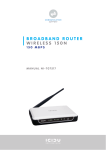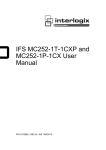Download CellPipe 7230 Business Gateway 100V Series 7230 BG 1VE.C2000
Transcript
CellPipe 7230 Business Gateway 100V series 7230 BG 1VE.C2000 QUICK INSTALLATION GUIDE 401-389-002 ISSUE 1 FEBRUARY 08 Alcatel, Lucent, Alcatel-Lucent and the Alcatel-Lucent logo are trademarks of Alcatel-Lucent. All other trademarks are the property of their respective owners. The information presented is subject to change without notice. Alcatel-Lucent assumes no responsibility for inaccuracies contained herein. Copyright © 2008 Alcatel-Lucent. All Rights Reserved. Conformance statements The device complies with Part 68 of the Federal Communications Commission (FCC) statements, Japan VCCI Class B, and the requirements of the Council Directive 89/336/EEC on the Approximation of the laws of the member states relating to Electromagnetic Compatibility and 72/23/EEC for electrical equipment used within certain voltage limits and the Amendment Directive 93/68/EEC as stated in the CE Mark Declaration of Conformance for EMI and Safety. For detailled conformance statements refer to the User Manual. QUICK Overview Purpose This Quick Installation Guide provides information about how to install the 7230 BG 1Ve.C2000 at the customers premises, which may be apartment blocks, hotels or office complexes. This customer premises equipment (CPE) supports Ethernet-over-VDSL2 via an Ethernet data link rated up to 100 Mb/s symmetric while simultaneously supporting standard telephone service. Via its bridge functionality, it connects any PC equipped with a 10BASE-T or 100BASE-TX network interface card via a standard telephone cable to a VDSL switch. For this purpose, it provides: • • • 1 VDSL port 1 port for telephony 1 LAN port (10/100BASE-TX). Reason for revision This version of the Quick Installation Guide is the first issue. Hardware description Package content The package consists of the following components: • • • • • • • One 7230 BG 1Ve.C2000 4 Rubber foot pads 1 Standard telephone cable (2.1 m / 7 ft.) 1 Category 5 UTP network cable (1.8 m / 6 ft.) 1 AC power adapter Quick Installation Guide User Manual on CD-ROM. Note: The AC-voltage is country-dependent, therefore the CellPipe 7230 BG 100V series is available with three different AC power adapters (7230 BG 1Ve.C2000EUR, 7230 BG 1Ve.C2000JPN, 7230 BG 1Ve.C2000UKD). .................................................................... 1 .................................................................... Front and rear view The front panel of the CPE provides several LEDs as system and port status indicators. The rear panel includes ports for the VDSL line, for connection to a telephone line, and a 10/100 Mb/s Ethernet connection to a PC. The rear panel also includes the DC power input connector. The following figures show the front panel with the LEDs and the rear panel with the different ports. Figure 1 Front and Rear Panels LED indications for system and port status The LEDs on the front panel indicate the following system and port status: LED Status Description System Status Indicators POWER On Power is being supplied to the CPE Off No power is being supplied to the CPE .................................................................... 2 .................................................................... LED Status Description DIAG On A failure has occurred during bootup diagnostics (including self-test failure). Flashing A loopback test is in progress. Off at the same time, the FAIL LED is flashing. A failure has been detected during operation. Off CPE is functioning properly Off CPE is functioning properly Flashing A failure has been detected during operation FAIL Port Status Indicators VDSL LAN On The VDSL port has a valid link with a VDSL switch, without data transmission Off The VDSL port has no link with a VDSL switch Slow Flashing1 Flashing during training Flashing The VDSL port has a valid link with a VDSL switch and is transmitting or receiving data On Ethernet port has a valid link with attached device Off Ethernet port has no link with other device Flashing CPE is transmitting or receiving data on this port Notes: 1 The slow flashing state is a periodic on-off cycle of approximately once per second. .................................................................... 3 .................................................................... Install the CPE When to use Use this procedure to install the 7230 BG 1Ve.C2000, that means to make the connections to the network, to the terminal equipment which may be a telephone or a fax machine, to the PC and to the power supply, and to establish a TCP/IP connection from the PC to the CPE. The following figure shows the CPE with all external connections established. This will be described step by step in the procedure below. Figure 2 Overview about all external connections System requirements 1. 2. 3. 4. The CPE should be located in a cool dry place, with at least 5 cm (2 in.) of space on all sides for ventilation. Place the CPE out of direct sunlight, and away from heat sources or areas with a high amount of electromagnetic interference. For power supply, the CPE requires 12 V DC via the included AC power adapter. The power adapter is designed for a 110/220 V AC connection. The CPE is a plug-and-play unit and not need any configuration or maintenance. For Internet access, a PC with a 10/100 Mb/s Ethernet adapter card installed is required. The PC must be configured for TCP/IP. .................................................................... 4 .................................................................... Related information For detailed information about the CPE refer to the User Manual on the attached CD-ROM. Before you begin Make sure that the package content is complete. Preserve original carton and packaging material. Procedure ............................................................................................................................................. 1 Connect one end of the attached standard telephone cable to the port on the CPE which is labeled LINE. Connect the other end to the telephone wall outlet providing the VDSL service. ............................................................................................................................................. 2 Connect a telephone or fax machine to the port on the CPE which is labeled PHONE. ............................................................................................................................................. 3 Connect one end of the Category 5 UTP network cable to the LAN port on the CPE and the other end to the port of the network interface on the PC. ............................................................................................................................................. 4 Connect the cord of the AC power adapter to the DC 12V power socket on the CPE which is labeled POWER. Then plug the power adapter directly into the AC power outlet. Result: The LED marked POWER on the front panel is on. ............................................................................................................................................. 5 Make sure that the Ethernet port of your PC is correctly configured for DHCP. For more details refer to Appendix B “Configuring the TCP/IP protocols on the PC”. ............................................................................................................................................. 6 Establish the first connection to the ISP provider. END OF STEPS ............................................................................................................................................. .................................................................... 5 .................................................................... .................................................................... 6 A Troubleshooting Overview Purpose This Appendix provides guidance for troubleshooting. The CPE operation can easily be monitored via the LED indicators to identify problems. The table below describes common problems you may encounter and possible solutions. Diagnosing Symptom Possible cause POWER LED does not light up after power on. Power outlet, power cord, or power adapter may be defective. LAN LED does not light up after making a connection. Network interface (e.g., a network adapter card in the attached computer), network cable, or the LAN port on the CPE may be defect. Solution • • • • • • VDSL LED is flashing slowly after making a connection. The cabling, or the LINE port on the CPE may be defect. • • Check the power outlet by plugging in another device that is functioning properly. Call the Customer Support Hotline or return the device to the vendor. Verify that the CPE and the computer are powered on. Make sure that the cable is plugged into both, the CPE and the PC. Verify that the proper cable type is used and its length does not exceed specified limits. Check the network adapter in the PC and the cable connections for possible defects. Replace the defective adapter or cable if necessary. Verify that the CPE is powered on. Make sure the cable is correctly plugged into the VDSL line wall outlet and the CPE connector labeled "LINE". .................................................................... 7 .................................................................... Symptom Possible cause Solution A phone call is not possible The cabling, or the PHONE port on the CPE may be defect. • • Verify that the CPE is powered on. Make sure the cable is correctly plugged into the telephone and the CPE connector labeled "PHONE". You cannot connect to the Internet The PC may not be configured as required or the network adapter driver may not fit. • Check that your PC is properly configured for TCP/IP. (see: Configuring the TCP/IP protocols on the PC page 9). Make sure the correct network adapter driver is installed for your operating system. If necessary, try reinstalling the driver. Check that the speed of the network adapter or duplex mode has not been configured manually. We recommend to set the adapter to auto-negotiation when installing the network driver. Did you establish your network connection before starting your browser? Verify your username and password entry in the network connection tab. • • • • .................................................................... 8 B Configuring the TCP/IP protocols on the PC Overview Purpose To connect the CPE to a PC through its Ethernet port, the PC must have an Ethernet network adapter card installed, and be configured for the TCP/IP protocol. Many service providers configure TCP/IP for client PC automatically using a networking technology known as Dynamic Host Configuration Protocol (DHCP). Other service providers may specify an IP configuration (known as a static IP address), which must be entered manually. Carry out the following steps to check that the computer’s Ethernet port is correctly configured for DHCP. Windows 95/98/NT 1. 2. 3. 4. 5. 6. 7. 8. Click “Start/Settings/Control Panel.” Click the “Network” icon. For Windows NT, click the “Protocols” tab. Select “TCP/IP” from the list of network protocols; this may include details of adapters installed in your computer. Click “Properties.” Check the option “Obtain an IP Address.” Click “OK” to close the TCP/IP Properties window. Restart your computer. Windows 2000 1. 2. 3. 4. Click “Start/Settings/Network/Dial-up Connections.” Click “Local Area Connections.” Select “TCP/IP” from the list of network protocols. Click on “Properties.” .................................................................... 9 .................................................................... 5. 6. 7. Select the option “Obtain an IP Address.” Click “OK” to close the TCP/IP Properties window. Restart your computer. Windows XP 1. 2. 3. 4. 5. 6. 7. Click “Start/Control Panel/Network Connections.” (You may need to choose Settings before Control Panel, depending on your Start Menu configuration.) Right-click the “Local Area Connection” icon for the adapter you want to configure, and choose “Properties.” Highlight “Internet Protocol (TCP/IP).” Click “Properties.” Select the option “Obtain an IP address automatically” and “Obtain DNS server address automatically.” Click “OK” to close the TCP/IP Properties window. Restart your computer. Windows Vista 1. 2. 3. 4. 5. 6. 7. 8. Click “Start/Control Panel/Network and Internet.” (You may need to choose Settings before Control Panel, depending on your Start Menu configuration.) Click “Network and Sharing Center” then click “Manage network connections.” Right-click the “Local Area Connection” and choose Properties. Select “Internet Protocol Version 4(TCP/IPv4).” Click “Properties.” Select “Obtain an IP address automatically” and “Obtain DNS server address automatically.” Click “OK” to close the TCP/IP Properties window. Restart your computer. Mac OS 1. 2. 3. 4. Pull down the Apple Menu. Click “Control Panels” and select “TCP/IP.” In the TCP/IP dialog box, verify that “Ethernet” is selected in the “Connect Via:” field. If “Using DHCP Server” is already selected in the “Configure” field, your computer is already configured for DHCP. Otherwise, select “Using DHCP Server” in the “Configure” field and close the window. Another box will appear asking whether you want to save your TCP/IP settings. Click “Save.” .................................................................... 10 .................................................................... 5. Your service provider will now be able to automatically assign an IP address to your computer. .................................................................... 11 .................................................................... .................................................................... 12





























